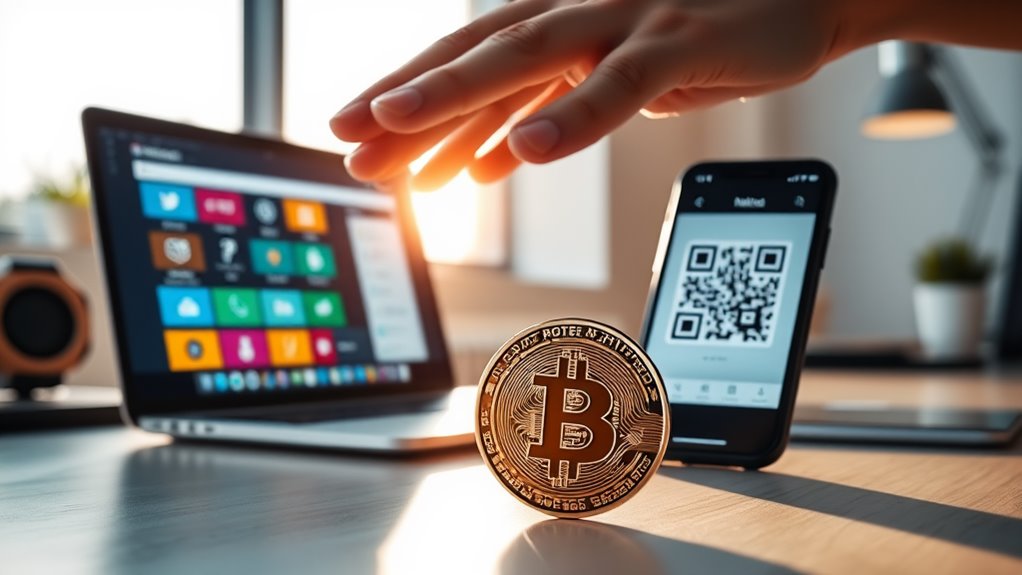
How Do Crypto Payments Work: A Step-by-Step Guide
Crypto payments work through a systematic process involving blockchain technology. Users set up digital wallets to store their cryptocurrencies. To initiate a payment, senders specify the recipient’s address and amount, signing the transaction with their private key. This transaction is then broadcasted to a network of nodes, which verify it for accuracy. Miners confirm and add valid transactions to the blockchain, creating an immutable record. Interested individuals can discover more about payment gateways and additional features.
Key Takeaways
- Initiate a crypto payment by specifying the recipient’s address and the transaction amount for processing.
- Digitally sign the transaction with your private key to authenticate the payment.
- Broadcast the signed transaction to the network, where it enters the mempool for validation.
- Miners verify the transaction, checking for sufficient funds and signature authenticity before including it in a block.
- Once confirmed, the transaction is added to the blockchain, ensuring its immutability and security.
Understanding Crypto Payments

In an increasingly digital world, understanding crypto payments is essential for both businesses and consumers alike. These payments provide rapid transaction speeds, enabling users to send funds globally without relying on traditional banks. Security is a key feature, as transactions are protected by the inherent qualities of blockchain technology, ensuring data integrity. However, the volatility of cryptocurrency values can complicate pricing and payment processing. Additionally, businesses must navigate ever-changing regulations to remain compliant. The advantages of crypto payments include lower transaction fees and broader market access, allowing merchants to reach customers worldwide. As the digital landscape evolves, gaining a solid grasp of these payment methods becomes increasingly important for effective participation in the global economy. Furthermore, using crypto payment processors can lead to enhanced security and reduce the risk of fraud in transactions.
The Blockchain Technology Behind Transactions

Blockchain technology serves as a decentralized ledger that securely records transactions within a cryptocurrency network. Each transaction undergoes a verification process, where network nodes play an essential role in validating the accuracy and authenticity of the data. This system ensures transparency and trust among participants without the need for intermediaries.
Decentralized Ledger Functionality
How does decentralized ledger functionality enhance the transparency and security of transactions? Decentralized ledgers, particularly blockchain technology, provide a transparent and secure framework for recording transactions. By distributing control across many nodes, they eliminate the risks associated with centralized systems. The immutability of blockchain entries guarantees that once a transaction is recorded, it cannot be altered, which bolsters trust among users. Additionally, blockchain-based payments offer faster and more cost-effective solutions for conducting transactions globally.
| Feature | Centralized Systems | Decentralized Systems |
|---|---|---|
| Control | Single Point of Control | Distributed Control |
| Data Integrity | Vulnerable to Tampering | Immutable Ledger |
| Accessibility | Limited Access | Open to All |
| Security | Risk of Single Failure | Enhanced Cryptographic Security |
| Consensus | Manual Approval | Automated Consensus |
Transaction Verification Process
The transaction verification process in cryptocurrency relies on a series of meticulous steps that guarantee accuracy and security. This process guarantees that each transaction is legitimate and prevents issues such as double spending.
Key components include:
- Transaction Creation: Senders digitally sign transactions with their private keys, guaranteeing authenticity.
- Validation by Nodes: Nodes check digital signatures and sender funds, guaranteeing protocol compliance.
- Consensus Mechanisms: Methods like Proof of Work and Proof of Stake validate transactions, maintaining network integrity.
- Block Formation: Validated transactions are grouped into blocks, securely linked to form an immutable blockchain.
Additionally, the process of crypto mining plays a crucial role in validating transactions and maintaining the network’s security. Together, these steps create a transparent and secure environment for cryptocurrency transactions, safeguarding against fraud and maintaining trust within the network.
Role of Network Nodes
In the domain of cryptocurrency transactions, network nodes play an essential role in maintaining the integrity and functionality of the system.
These nodes come in various types, including full nodes, light nodes, and mining nodes. Full nodes store complete copies of the blockchain ledger, guaranteeing decentralization and security. They validate and propagate transactions and blocks, contributing to network integrity by preventing manipulation.
The decentralized nature of nodes enhances security, as they collaboratively verify transactions to reach consensus. This cooperation guarantees consistency across the network, making it resilient against failures.
Additionally, nodes utilize cryptographic principles to secure transactions, facilitating fast and transparent payments on a global scale while promoting financial inclusion for underserved populations. Implementing robust security measures is essential for protecting these transactions from potential threats.
Setting Up a Digital Wallet

Setting up a digital wallet is an essential step for anyone looking to manage their financial transactions effectively in today’s increasingly digital world. Digital wallets, also known as e-wallets, allow users to store and manage various payment methods securely.
- Types: Includes traditional wallets like Apple Pay and cryptocurrency wallets like Bitcoin wallets.
- Setup Process: Requires downloading the app, adding payment methods, and verifying identity.
- Purpose: Facilitates secure transactions and organizes personal financial documents like tickets.
- Security Measures: Involves encryption, two-factor authentication (2FA), and regular updates to protect user data. Crypto wallets, in particular, are crucial for users to securely interact with the cryptocurrency ecosystem.
Understanding these aspects guarantees users can confidently navigate their digital wallet setup while prioritizing security and convenience.
Initiating a Crypto Payment

Initiating a crypto payment begins when a customer selects cryptocurrency as their preferred payment method during checkout.
This action triggers a connection to a crypto payment gateway, which displays the available cryptocurrency options and generates a unique wallet address, often represented as a QR code, for the transaction.
Customers can then enter the payment amount, ensuring they understand the real-time exchange rates that reflect the fiat value of their chosen cryptocurrency. Additionally, the crypto payment gateway facilitates secure transactions by eliminating intermediaries such as banks.
Wallet Setup Process
When a user decides to engage in cryptocurrency transactions, the wallet setup process becomes an essential first step in managing digital assets. Selecting the right type of wallet is vital, as options include software, hardware, paper, hosted, and non-custodial wallets, each serving different needs.
- Download from official sources for security.
- Create an account with a strong password and enable 2FA.
- Keep private keys and recovery phrases secure.
- Obtain the wallet’s public address for receiving funds.
Following these steps guarantees users can safely manage and transact with their cryptocurrencies. Additionally, choosing a wallet that supports supported cryptocurrencies ensures that users can efficiently handle the specific digital assets they intend to use.
Proper setup not only enhances security but also facilitates a smoother experience in the world of digital currencies.
Transaction Confirmation Steps
After successfully setting up a cryptocurrency wallet, the next step involves understanding how to confirm transactions, which is pivotal for ensuring that payments are processed correctly.
To initiate a crypto payment, the user specifies the recipient’s cryptocurrency address and the transfer amount. The transaction is then digitally signed with the sender’s private key, ensuring its authenticity.
This signed transaction is broadcasted to the network and enters a waiting area known as the mempool. Here, nodes verify the transaction’s structure and signatures, ensuring that inputs have not been previously spent.
Once verified, miners select transactions from the mempool, include them in a new block, and add that block to the blockchain, confirming the transaction. This process typically takes a few minutes to an hour, depending on network congestion.
The Verification Process

The verification process in cryptocurrency transactions is essential for confirming the authenticity and integrity of each transaction. This process involves multiple steps and mechanisms that work together to validate transactions before they are added to the blockchain.
The verification process in cryptocurrency ensures each transaction’s authenticity and integrity before it’s added to the blockchain.
Key elements include:
- Transactions are broadcast to the network for validation.
- Nodes check for sufficient funds and the authenticity of digital signatures.
- Decentralized consensus confirms all participating nodes agree on the transaction’s legitimacy.
- Cryptographic puzzles, solved by miners, secure the process against fraud.
Once verified, transactions are grouped into blocks and added to the blockchain, making them immutable. The integration of technologies like the Lightning Network enhances the verification process by enabling faster and more cost-effective transactions.
This robust verification procedure helps maintain trust and security in the cryptocurrency ecosystem, allowing users to transact with confidence.
Role of Crypto Payment Gateways

Crypto payment gateways serve as essential intermediaries that facilitate transactions between consumers and businesses, enabling a seamless integration of cryptocurrency into everyday commerce. These gateways allow businesses to accept cryptocurrency and convert it into fiat currency, guaranteeing that transactions are secure and efficient. They utilize blockchain technology, which supports fast processing and reduces transaction fees. Additionally, crypto payment gateways eliminate chargebacks, enhancing security for merchants.
| Feature | Benefit |
|---|---|
| Lower Transaction Fees | Cost-effective compared to traditional systems |
| Fast Processing | Transactions are completed quickly |
| Enhanced Security | Advanced encryption guarantees safe transactions |
Through their user-friendly interfaces, popular gateways like BitPay and Coinbase Commerce allow businesses to engage a broader, global customer base without currency restrictions.
Optional Services and Features

Optional services and features offered by crypto payment gateways enhance the overall experience for both businesses and customers. These additional functionalities streamline transactions and improve usability, making crypto payments more accessible.
- Currency Conversion: Automatically converts currencies for user convenience.
- Wallet Integration: Seamlessly connects with various digital wallets.
- Invoicing and Payment Requests: Enables easy generation of invoices in cryptocurrencies.
- Cross-Border Efficiency: Facilitates quick and cost-effective international transactions.
These features not only simplify the payment process but also provide enhanced security and support.
Developing Your Own Crypto Payment Gateway

Developing a crypto payment gateway requires careful planning and execution, as various factors must be considered to guarantee its success.
Initially, conducting a market analysis helps identify demand and competitors, enabling informed decisions. A clear technical vision outlines the gateway’s purpose and features. Selecting the right blockchain, such as Ethereum or Solana, is vital for supporting transactions. Appropriate technologies, like React.js for the user interface and Solidity for smart contracts, optimize development.
Integrating core components, such as KYC/AML protocols and user-friendly APIs, enhances security and usability. Ensuring compliance with regulations is essential for transparency.
Finally, employing CI/CD pipelines fosters streamlined development, while ongoing performance monitoring and updates keep the gateway functional and user-friendly, ensuring a positive experience for all users.
Frequently Asked Questions
Can I Cancel a Crypto Payment Once Initiated?
Once initiated, a crypto payment generally cannot be canceled. However, unconfirmed transactions may be replaced using the replace-by-fee (RBF) method. Once confirmed on the blockchain, transactions become irreversible, making cancellation impossible.
What Happens if I Send Crypto to the Wrong Address?
Sending crypto to the wrong address can feel like tossing money into a black hole. If the address is active, recovery is nearly impossible; if nonexistent, funds remain safe in the sender’s wallet, untouched.
Are Crypto Payments Irreversible?
Crypto payments are indeed irreversible. Once confirmed on the blockchain, transactions cannot be altered or refunded, ensuring security against fraud but necessitating careful verification to prevent costly errors, such as sending funds to incorrect addresses.
How Do Taxes Apply to Crypto Transactions?
Steering through the labyrinth of crypto taxes reveals complexities. Taxes apply to various transactions, such as selling or earning crypto, with capital gains and income taxes based on profits. Proper record-keeping is essential for compliance and accurate reporting.
Is Cryptocurrency Legal for Payments Everywhere?
Cryptocurrency payment legality varies globally. While many countries accept it, others impose stringent regulations or outright bans. Jurisdictional differences create a complex landscape for users, necessitating awareness of local laws and potential tax implications.
Conclusion
In summary, understanding crypto payments is essential in today’s digital economy. From the underlying blockchain technology to setting up a wallet, each step plays a critical role in crafting seamless transactions. As businesses increasingly adopt these payment methods, the potential for growth in the crypto sphere is astronomical. By exploring options like payment gateways, individuals and companies can benefit from enhanced efficiency and security in their financial dealings. Embracing this technology may just revolutionize the way we think about money.












